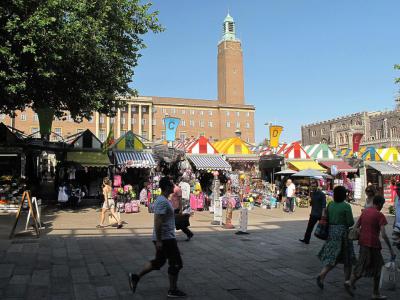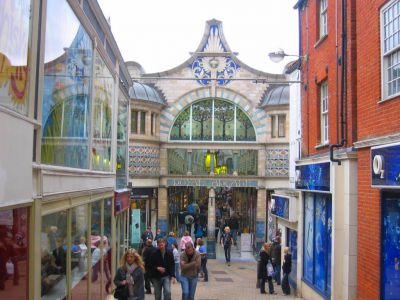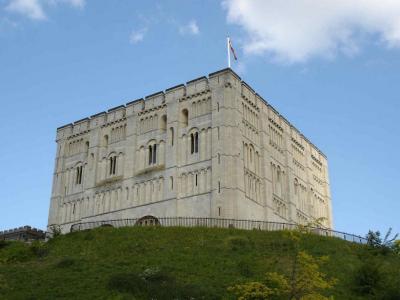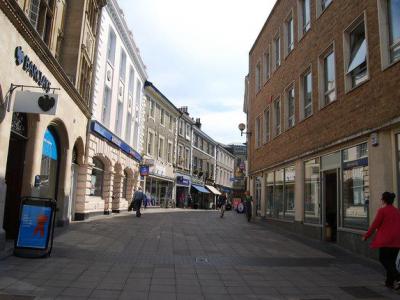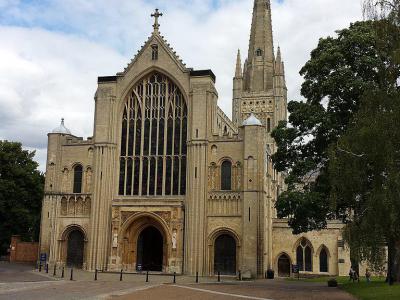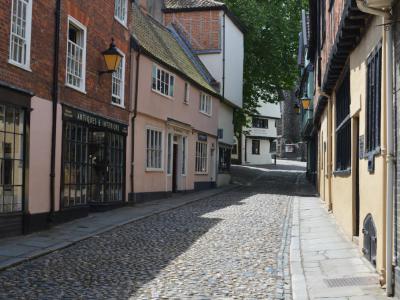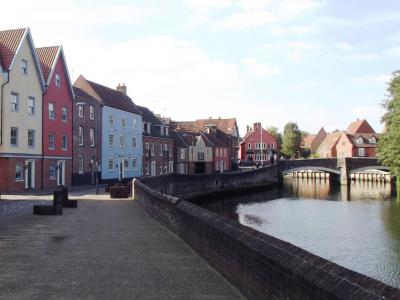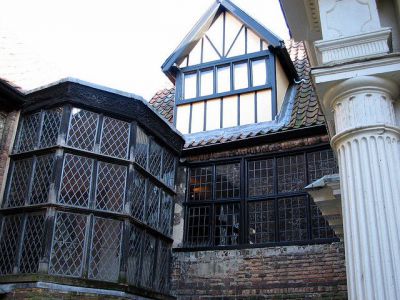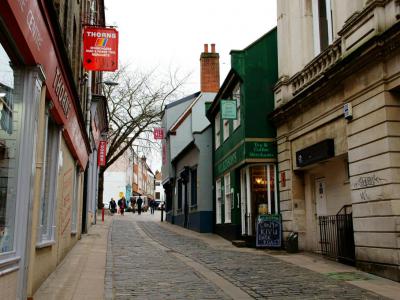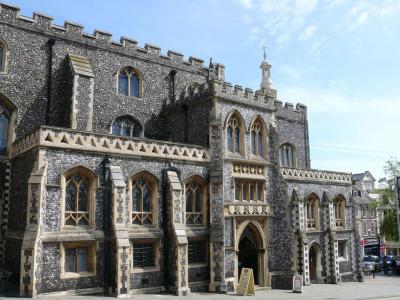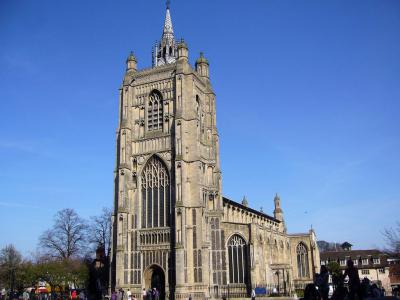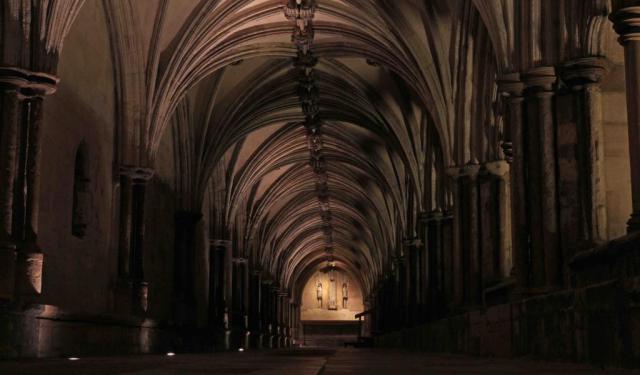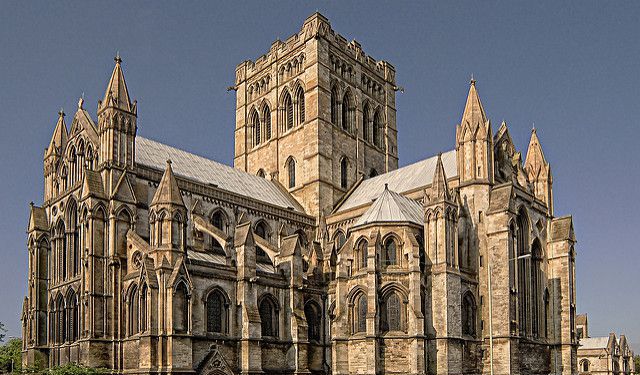
Norwich Introduction Walking Tour (Self Guided), Norwich
The Iceni tribe predated the Romans in the village of Caistor, near the area of present-day Norwich. In 60 AD an uprising led by Boudica had been put down and Caistor became the Roman capital of East Anglia. Anglo-Saxons settled the town of Northwic in the 4th century. By the 10th century Northwic became Norwich, a prosperous trading center.
William the Conqueror arrived with a bang in 1066. The Normans heartily set to work. They built the Norwich Castle. Around the Castle a market and a Norman village was created. In 1096 construction of the great Norwich Cathedral began. Norwich became a walled city of churches, hospitals and friaries, financed by a burgeoning wool trade.
The Tudor era in the 16th century brought revolutionary changes. The Protestant Reformation, peasant rebellions, and waves of religious refugees from the continent, brought new skills and enterprises with them. Cromwell brought civil war and churned life in general but after the restoration in 1660, Norwich had its economic golden age.
In the 17th and 18th centuries the Norwich area had its share of civic and social upheavals. Jacobitism, Whigs and Tories, plagues, dissents and reforms had generated a metropolitan if not cosmopolitan culture and sophisticated politics. Intellectual life flourished and the city billed itself as "The Athens of England."
Life in Norwich in the 19th century showed marked improvement. The first public library opened in 1857. The Chapelfield Public Park opened in 1852 and Mousehold Heath in 1886. The Roman Catholic Cathedral of St. John the Baptist was built in 1884. The Castle Museum in the Norman Castle opened in 1894, the Royal Arcade in 1899.
Norwich is a blend of the medieval and modern. Come and visit Elm Hlll, the Forum, the Plantation Gardens, Strangers Hall, the Wensum River Walk, the Museum of Norwich, restaurants and pubs from the 15th century, and a market square that has been operating for 900 years. Like William, come, conquer and be conquered.
William the Conqueror arrived with a bang in 1066. The Normans heartily set to work. They built the Norwich Castle. Around the Castle a market and a Norman village was created. In 1096 construction of the great Norwich Cathedral began. Norwich became a walled city of churches, hospitals and friaries, financed by a burgeoning wool trade.
The Tudor era in the 16th century brought revolutionary changes. The Protestant Reformation, peasant rebellions, and waves of religious refugees from the continent, brought new skills and enterprises with them. Cromwell brought civil war and churned life in general but after the restoration in 1660, Norwich had its economic golden age.
In the 17th and 18th centuries the Norwich area had its share of civic and social upheavals. Jacobitism, Whigs and Tories, plagues, dissents and reforms had generated a metropolitan if not cosmopolitan culture and sophisticated politics. Intellectual life flourished and the city billed itself as "The Athens of England."
Life in Norwich in the 19th century showed marked improvement. The first public library opened in 1857. The Chapelfield Public Park opened in 1852 and Mousehold Heath in 1886. The Roman Catholic Cathedral of St. John the Baptist was built in 1884. The Castle Museum in the Norman Castle opened in 1894, the Royal Arcade in 1899.
Norwich is a blend of the medieval and modern. Come and visit Elm Hlll, the Forum, the Plantation Gardens, Strangers Hall, the Wensum River Walk, the Museum of Norwich, restaurants and pubs from the 15th century, and a market square that has been operating for 900 years. Like William, come, conquer and be conquered.
How it works: Download the app "GPSmyCity: Walks in 1K+ Cities" from Apple App Store or Google Play Store to your mobile phone or tablet. The app turns your mobile device into a personal tour guide and its built-in GPS navigation functions guide you from one tour stop to next. The app works offline, so no data plan is needed when traveling abroad.
Norwich Introduction Walking Tour Map
Guide Name: Norwich Introduction Walking Tour
Guide Location: England » Norwich (See other walking tours in Norwich)
Guide Type: Self-guided Walking Tour (Sightseeing)
# of Attractions: 11
Tour Duration: 2 Hour(s)
Travel Distance: 2.5 Km or 1.6 Miles
Author: Maia
Sight(s) Featured in This Guide:
Guide Location: England » Norwich (See other walking tours in Norwich)
Guide Type: Self-guided Walking Tour (Sightseeing)
# of Attractions: 11
Tour Duration: 2 Hour(s)
Travel Distance: 2.5 Km or 1.6 Miles
Author: Maia
Sight(s) Featured in This Guide:
- Norwich Market
- Royal Arcade
- Norwich Castle
- London Street
- Norwich Cathedral
- Elm Hill
- Riverside Walk
- Strangers Hall Museum
- Norwich Lanes
- Norwich Guildhall
- St. Peter Mancroft Church
1) Norwich Market (must see)
In the 10th century, during the reign of Good King Aethelstan, the settlement of Norwich was already a major trading center. The Anglo-Saxon town was centered around the open market space called Tombland. A piece of the Tombland space is still there. It's a small triangular bit of park with a few trees and a telephone call-box.
The Normans demolished most of Tombland in the 11th century to make room for their own town and market. They built Norwich Cathedral and Norwich Castle. The new market gradually supplanted the old one and it has been in operation for over 900 years. The Norwich Market today looks nearly the same as it did in the 14th century.
The market is a rectangle running north and south. On the north side was a tollhouse. This building was replaced in 1413 by the Guildhall. The St. Peter's Street (Overowe) borders the west side with the City Hall which was built in 1938. The old Norman Church of St Peter Mancroft is in the south. On the east is the Gentlemen's Walk (Netherowe).
In the market area there are more than 200 permanent stalls. There are 29 stalls operated by food vendors and the remainder are held by other enterprises. In 2004 the market was rearranged in parallel rows of stall units of steel called "pods", holding four stalls each. Transparent retractable canopies cover the alleyways between pods.
The Normans demolished most of Tombland in the 11th century to make room for their own town and market. They built Norwich Cathedral and Norwich Castle. The new market gradually supplanted the old one and it has been in operation for over 900 years. The Norwich Market today looks nearly the same as it did in the 14th century.
The market is a rectangle running north and south. On the north side was a tollhouse. This building was replaced in 1413 by the Guildhall. The St. Peter's Street (Overowe) borders the west side with the City Hall which was built in 1938. The old Norman Church of St Peter Mancroft is in the south. On the east is the Gentlemen's Walk (Netherowe).
In the market area there are more than 200 permanent stalls. There are 29 stalls operated by food vendors and the remainder are held by other enterprises. In 2004 the market was rearranged in parallel rows of stall units of steel called "pods", holding four stalls each. Transparent retractable canopies cover the alleyways between pods.
2) Royal Arcade
The Royal Arcade is close by the Norwich Market, between Gentlemen's Walk and Castle Street. In contrast to the medieval market square atmosphere of the Market, the Arcade is an ornate Art-Nouveau Victorian mall. It offers a more upscale shopping experience with its unique architecture and specialty shopping outlets.
The arcade opened in 1899. It is a covered avenue up to 250 feet long. It was designed and built by architect George Skipper. The walls of the upper floor of the arcade are adorned with tiles. The tiles show themes from nature, especially floral arrangements and peacocks.
The Art-Nouveau style is reflected in the floor tiles. Under the glass gallery roof hang wrought iron and glass lanterns. These were added to the Arcade as part of the restoration of the 1980s. At its opening in 1899 the Arcade was called a "fragment from the Arabian Nights" appearing in the old city center.
Retailers in the Arcade include antique galleries, sweet shops, toys and games, cafes, fashion shops, jewelers, etc.
The Arcade has three entrances connected to the Norwich pedestrianized shopping streets. It is across the street from the Norwich Market.
The arcade opened in 1899. It is a covered avenue up to 250 feet long. It was designed and built by architect George Skipper. The walls of the upper floor of the arcade are adorned with tiles. The tiles show themes from nature, especially floral arrangements and peacocks.
The Art-Nouveau style is reflected in the floor tiles. Under the glass gallery roof hang wrought iron and glass lanterns. These were added to the Arcade as part of the restoration of the 1980s. At its opening in 1899 the Arcade was called a "fragment from the Arabian Nights" appearing in the old city center.
Retailers in the Arcade include antique galleries, sweet shops, toys and games, cafes, fashion shops, jewelers, etc.
The Arcade has three entrances connected to the Norwich pedestrianized shopping streets. It is across the street from the Norwich Market.
3) Norwich Castle (must see)
Norwich Castle was founded some time between 1066 and 1075 by William the Conqueror, the first Norman king of England, in the aftermath of the Norman conquest of England. Early in 1067, William embarked on a campaign to subjugate East Anglia, and it was probably around this time that the castle was established.
To clear space for the fort (which initially took the form of a wooden motte and bailey) the Normans demolished about 100 Saxon homes. In 1094 the construction was begun by King William (The Red) II, third son of William the Conqueror, on the stone keep which would later become Norwich Castle. King Henry I completed the work in 1121.
Parts of the castle were used as a gaol (prison), from 1220 to 1887. This was until Prison Norwich was opened at Mousehold Heath and the property was converted into a museum. The Museum and Art Gallery officially opened in 1894. The displayed here historical artifacts – of Roman, Egyptian, Saxon and Viking origins – include ceramics, porcelain and silver objects as well as paintings of the Norwich School.
The dark history of the castle, however, (as a gaol, it was routinely used for public hangings) today manifests in the form of ghostly sightings. Among them a floating skull, a mythical king (Gurgunt), a rebel leader (Robert Kett), and an old lady dressed in black.
The king is believed to have been buried within the hill of the castle with all his riches after falling into an eternal sleep. The woman is said to have been hung for murdering her husband. The museum staff sometimes spotted her in the art gallery under the castle mound, and prior to them, in 1820, terrified prisoners at the castle reported seeing her floating off the ground.
As for the rebel leader, Robert Kett, he was accused of high treason for leading a peasant revolt, now known as Kett's Rebellion, and was hanged at the castle after being tried at the Tower of London. Over the years there have been reports of an apparition of his rotting corpse hanging outside. A wall plaque placed at the entrance to the Museum in 1949 commemorates the 400th anniversary of Robert Kett's execution, saying: “This memorial was placed here by the citizens of Norwich in reparation and honour to a notable and courageous leader in the long struggle of the common people of England to escape from a servile life into the freedom of just conditions.”
Lastly in 1844, the devil was allegedly seen by two people (presumably prisoners) dancing on the castle walls.
Tips:
For extra fun there are tours of dungeons and battlements; and there is a café.
To clear space for the fort (which initially took the form of a wooden motte and bailey) the Normans demolished about 100 Saxon homes. In 1094 the construction was begun by King William (The Red) II, third son of William the Conqueror, on the stone keep which would later become Norwich Castle. King Henry I completed the work in 1121.
Parts of the castle were used as a gaol (prison), from 1220 to 1887. This was until Prison Norwich was opened at Mousehold Heath and the property was converted into a museum. The Museum and Art Gallery officially opened in 1894. The displayed here historical artifacts – of Roman, Egyptian, Saxon and Viking origins – include ceramics, porcelain and silver objects as well as paintings of the Norwich School.
The dark history of the castle, however, (as a gaol, it was routinely used for public hangings) today manifests in the form of ghostly sightings. Among them a floating skull, a mythical king (Gurgunt), a rebel leader (Robert Kett), and an old lady dressed in black.
The king is believed to have been buried within the hill of the castle with all his riches after falling into an eternal sleep. The woman is said to have been hung for murdering her husband. The museum staff sometimes spotted her in the art gallery under the castle mound, and prior to them, in 1820, terrified prisoners at the castle reported seeing her floating off the ground.
As for the rebel leader, Robert Kett, he was accused of high treason for leading a peasant revolt, now known as Kett's Rebellion, and was hanged at the castle after being tried at the Tower of London. Over the years there have been reports of an apparition of his rotting corpse hanging outside. A wall plaque placed at the entrance to the Museum in 1949 commemorates the 400th anniversary of Robert Kett's execution, saying: “This memorial was placed here by the citizens of Norwich in reparation and honour to a notable and courageous leader in the long struggle of the common people of England to escape from a servile life into the freedom of just conditions.”
Lastly in 1844, the devil was allegedly seen by two people (presumably prisoners) dancing on the castle walls.
Tips:
For extra fun there are tours of dungeons and battlements; and there is a café.
4) London Street
In July 1967 Norwich Street became the first street in the United Kingdom to be pedestrianized. Several UK towns had made plans to pedestrianize as early as 1960. Things never got past the planning stage. Everything was shelved in the face of opposition from shopkeepers and retailers.
Then, suddenly things changed. The London Street sewer had collapsed. The street was closed to car traffic. Only pedestrians were allowed on the street. Retailers on London Street were suddenly busy as never before. Putting people before automobiles was now a great idea. Fifty years later the idea of shopping without a car is a no-brainer.
London Street is basically an expensive place to shop. It might be called the jewelry center of the city. The street is home to Chapelfield Shopping Plaza, Castle Quarter, Furniture Village, Bear Shop (for toys), Head in the Clouds (for gifts and jewelry), The Free Shop (for phones and vintage items), Langleys (for toys), and the House of Fraser, a department store.
Then, suddenly things changed. The London Street sewer had collapsed. The street was closed to car traffic. Only pedestrians were allowed on the street. Retailers on London Street were suddenly busy as never before. Putting people before automobiles was now a great idea. Fifty years later the idea of shopping without a car is a no-brainer.
London Street is basically an expensive place to shop. It might be called the jewelry center of the city. The street is home to Chapelfield Shopping Plaza, Castle Quarter, Furniture Village, Bear Shop (for toys), Head in the Clouds (for gifts and jewelry), The Free Shop (for phones and vintage items), Langleys (for toys), and the House of Fraser, a department store.
5) Norwich Cathedral (must see)
Norwich Cathedral is an Anglican cathedral featuring primarily a Norman style.
They say the first bishop of Norwich, Herbert de Losinga, was not without a sin (vanity, most likely). He bought his job from the king, no less, in 1094, for 1,900 pounds. Ensconced in his new see, the bishop wasted no time in building a cathedral for himself, which started in 1096. To make room for the nascent structure, an Anglo-Saxon settlement and two churches were demolished, plus a canal was specially dug to allow access for the boats bringing the stone and construction materials up the River Wensum.
Herbert had barely parked his throne in the nave when he died in 1119, upon which the construction was carried on by his successor, Bishop Eborard, in 1121. It was finally completed in 1145 when Eborard's successor, Bishop William de Turbe, installed the cathedral tower. The entire building was put together with flint and mortar, and faced with white limestone from Caen, France.
Norwich Cathedral boasts a really long nave with 14 bays, and has the second largest cloister in England, exceeded only by that at Salisbury Cathedral. The cathedral's stone spire, measuring at 315 ft (96 m), is the second-tallest in England (also second to Salisbury) was added in 1169. Measuring 461 ft (141 m) and 177 ft (54 m) wide at completion, Norwich Cathedral was once the largest building in East Anglia.
The bosses of Norwich Cathedral in the cloisters – hundreds of carved and ornately painted images of kings, peasants, musicians, soldiers, acrobats, and ladies – are among the world's greatest medieval sculptural treasures that survived the iconoclasm of the Tudor and English Civil War periods.
Before the high altar is the tomb of Bishop Herbert de Losinga. Close by there is a bas relief marking the 900th anniversary of the cathedral. Indeed, Norwich Cathedral has a long and storied history, judging by which it is not surprising there have been several interesting ghost sightings here, including those of a bishop, a local hero, a Catholic priest and a mysterious woman, and not just at night!
The main ghost story related to the Cathedral is a photograph of a ghostly figure, which many identified as one of the bishops buried within the cathedral grounds, taken in 2015. Another ghost story comes from 1736 where a man reportedly saw the ghost of a martyred priest walking around Erpingham Gate (one of the entrances into the Norwich Cathedral grounds). Its description sounded like the Rev. Thomas Tunstall, a Catholic martyr, who was hanged, drawn and quartered just outside what was likely Magdalen Gates; his body parts were displayed afterwards throughout the city.
Lastly, during some renovations of one of the cathedral’s buildings, tools and other items were seen moving of their own accord. It all stopped, though, as soon as church officials arrived at the scene.
They say the first bishop of Norwich, Herbert de Losinga, was not without a sin (vanity, most likely). He bought his job from the king, no less, in 1094, for 1,900 pounds. Ensconced in his new see, the bishop wasted no time in building a cathedral for himself, which started in 1096. To make room for the nascent structure, an Anglo-Saxon settlement and two churches were demolished, plus a canal was specially dug to allow access for the boats bringing the stone and construction materials up the River Wensum.
Herbert had barely parked his throne in the nave when he died in 1119, upon which the construction was carried on by his successor, Bishop Eborard, in 1121. It was finally completed in 1145 when Eborard's successor, Bishop William de Turbe, installed the cathedral tower. The entire building was put together with flint and mortar, and faced with white limestone from Caen, France.
Norwich Cathedral boasts a really long nave with 14 bays, and has the second largest cloister in England, exceeded only by that at Salisbury Cathedral. The cathedral's stone spire, measuring at 315 ft (96 m), is the second-tallest in England (also second to Salisbury) was added in 1169. Measuring 461 ft (141 m) and 177 ft (54 m) wide at completion, Norwich Cathedral was once the largest building in East Anglia.
The bosses of Norwich Cathedral in the cloisters – hundreds of carved and ornately painted images of kings, peasants, musicians, soldiers, acrobats, and ladies – are among the world's greatest medieval sculptural treasures that survived the iconoclasm of the Tudor and English Civil War periods.
Before the high altar is the tomb of Bishop Herbert de Losinga. Close by there is a bas relief marking the 900th anniversary of the cathedral. Indeed, Norwich Cathedral has a long and storied history, judging by which it is not surprising there have been several interesting ghost sightings here, including those of a bishop, a local hero, a Catholic priest and a mysterious woman, and not just at night!
The main ghost story related to the Cathedral is a photograph of a ghostly figure, which many identified as one of the bishops buried within the cathedral grounds, taken in 2015. Another ghost story comes from 1736 where a man reportedly saw the ghost of a martyred priest walking around Erpingham Gate (one of the entrances into the Norwich Cathedral grounds). Its description sounded like the Rev. Thomas Tunstall, a Catholic martyr, who was hanged, drawn and quartered just outside what was likely Magdalen Gates; his body parts were displayed afterwards throughout the city.
Lastly, during some renovations of one of the cathedral’s buildings, tools and other items were seen moving of their own accord. It all stopped, though, as soon as church officials arrived at the scene.
6) Elm Hill (must see)
There are no elms in Elm Hill. The neighborhood acquired its name from the elm trees planted there in the 16th century by the Churchwardens of St. Peter Hungate Church. Because there is Dutch elm disease in the UK, there has been no effort to bring back elms to Elm Hill.
There is some evidence of settlement around Elm Hill as far back as 1200. Almost all of Elm Hill was destroyed by fire. The early Tudor Britons Arms is the only surviving building that dates before 1507. Elm Hill extends from the Church of St. Peter Hungate at Princes Street to the Church if St. Simon and St. Jude at Wensum Street.
The north side of of Elm Hill is parallel to the river Wensum. This area once was the location of wealthy merchant houses and their quays. The river was a busy commercial thoroughfare in the 15th and 16th centuries. Barges carried raw materials and finished products to and from the city.
In 1927 the Norwich corporation carried out a renovation project in Elm Hill aimed at preserving the original medieval appearance of the cobble stone streets and landmark Tudor tiered buildings. The Stranger's Club, the Pettus House, the Tea House in Wrights Court and the Dormouse Bookshop are recommended for a visit.
There is some evidence of settlement around Elm Hill as far back as 1200. Almost all of Elm Hill was destroyed by fire. The early Tudor Britons Arms is the only surviving building that dates before 1507. Elm Hill extends from the Church of St. Peter Hungate at Princes Street to the Church if St. Simon and St. Jude at Wensum Street.
The north side of of Elm Hill is parallel to the river Wensum. This area once was the location of wealthy merchant houses and their quays. The river was a busy commercial thoroughfare in the 15th and 16th centuries. Barges carried raw materials and finished products to and from the city.
In 1927 the Norwich corporation carried out a renovation project in Elm Hill aimed at preserving the original medieval appearance of the cobble stone streets and landmark Tudor tiered buildings. The Stranger's Club, the Pettus House, the Tea House in Wrights Court and the Dormouse Bookshop are recommended for a visit.
7) Riverside Walk (must see)
The Riverside Walk takes a path alongside the river Wensum. The walk starts at the forum in the center of town. The alternate starting place is the train station. The river is close by. The walk follows a path on both sides of the river, including a break at Norwich Cathedral.
The route along the riverbank is scenic with nature, bridges and historical buildings. Points of interest include the historic New Mills Pumping House, the medieval Watergate of Pulls Ferry, the Cow Tower and a 14th century artillery tower. The walk may be extended to take in Whitlingham Country Park and the trails of Mousehead Heath.
The Walk connects to paths leading away from the city. Wherryman's Way leads to Great Yarmouth through the Yare Valley. The Boudica Way is a long distance path to Stoatsham mill and ford. Ketts County Walk and Tas Valley Way follow the river Tas. The Walsingham Way starts and finishes in the city.
The route along the riverbank is scenic with nature, bridges and historical buildings. Points of interest include the historic New Mills Pumping House, the medieval Watergate of Pulls Ferry, the Cow Tower and a 14th century artillery tower. The walk may be extended to take in Whitlingham Country Park and the trails of Mousehead Heath.
The Walk connects to paths leading away from the city. Wherryman's Way leads to Great Yarmouth through the Yare Valley. The Boudica Way is a long distance path to Stoatsham mill and ford. Ketts County Walk and Tas Valley Way follow the river Tas. The Walsingham Way starts and finishes in the city.
8) Strangers Hall Museum
In the 1320s one Ralph de Middleton owned a house on the site of the current Strangers Hall Museum. Ralph's house is gone but the undercroft is intact under the Museum. How is it now Strangers Hall? How did it become a museum?
The building was considered prestigious. Mayors and merchants made changes and additions to show their social status. The great hall itself was built in the 15th century by William Barley, a cloth merchant. During the 16th century, Thomas Southerton, mayor and greengrocer owned the house when the strangers arrived.
The first "strangers" were religious refugees from the Netherlands; Walloon and Flemish Calvanists fleeing persecution by Spanish Catholic rulers. Protestant asylum seekers were welcome. England was a protestant country under Queen Elizabeth I. The "strangers" brought their skills, energy, and knowledge with them and Norwich prospered.
Subsequent tenants/owners made modifications to the house: a crown post roof, a mullioned bay window, a vaulted porch and steps giving access to the Great Hall. The Great Chamber was a wing of the Great Hall. The Georgian dining room was installed in 1748.
By the 1890s, however, the Strangers Hall had fallen into disrepair. In 1899 Leonard Bolingbroke bought the building. In 1900 he opened it to the public as a folk museum. In 1922 the Hall as museum was presented to the city of Norwich.
The building was considered prestigious. Mayors and merchants made changes and additions to show their social status. The great hall itself was built in the 15th century by William Barley, a cloth merchant. During the 16th century, Thomas Southerton, mayor and greengrocer owned the house when the strangers arrived.
The first "strangers" were religious refugees from the Netherlands; Walloon and Flemish Calvanists fleeing persecution by Spanish Catholic rulers. Protestant asylum seekers were welcome. England was a protestant country under Queen Elizabeth I. The "strangers" brought their skills, energy, and knowledge with them and Norwich prospered.
Subsequent tenants/owners made modifications to the house: a crown post roof, a mullioned bay window, a vaulted porch and steps giving access to the Great Hall. The Great Chamber was a wing of the Great Hall. The Georgian dining room was installed in 1748.
By the 1890s, however, the Strangers Hall had fallen into disrepair. In 1899 Leonard Bolingbroke bought the building. In 1900 he opened it to the public as a folk museum. In 1922 the Hall as museum was presented to the city of Norwich.
9) Norwich Lanes
The Norwich Lanes, known locally as The Lanes, is an area of Norwich. It consists of a series of mostly pedestrian-oriented small lanes, alleyways and streets. Norwich Lanes is noted for its independent retailers, and eating and drinking establishments.
The area also contains some of the city's cultural attractions, including museums, theatres, pubs and bars. As part of a nationwide drive to recognize the importance of the character and individuality of Britain's high streets, and to maintain it, Norwich Lanes won the Great British High Street Awards 2014.
The area also contains some of the city's cultural attractions, including museums, theatres, pubs and bars. As part of a nationwide drive to recognize the importance of the character and individuality of Britain's high streets, and to maintain it, Norwich Lanes won the Great British High Street Awards 2014.
Sight description based on Wikipedia.
10) Norwich Guildhall
In 1404 Henry IV, king of England, granted a charter of autonomy to the city of Norwich. Immediately the city needed a town hall. The old Tollhouse would not be enough for an autonomous city. Construction on the Guildhall started in 1407. The project was completed in 1413.
The roof of the council chamber collapsed in 1511. It was restored in 1537. In those days only the craftsmen were paid. Laborers were pressed into service without pay. A working day would go from dawn to dusk. The quality of work could be a little iffy.
The Guildhall was the largest municipal building in Suffolk. There were two main halls on the upper floor. These were for meetings and courts. The larger hall was the Assembly Chamber, Sheriff's Court and Sword Room. The armory was on the upper level. The ground floor was for unchained prisoners. The toughies were kept below.
Thomas Bilney, an iconoclastic clergyman well ahead of his time, was held below in the undercroft of the Guildhall. He was charged with heresy and burned at the stake in 1531. The Guildhall was the seat of government until 1938, when the new City Hall opened for business. The Office of the Sheriff of Norwich is in the Guildhall chapel.
The roof of the council chamber collapsed in 1511. It was restored in 1537. In those days only the craftsmen were paid. Laborers were pressed into service without pay. A working day would go from dawn to dusk. The quality of work could be a little iffy.
The Guildhall was the largest municipal building in Suffolk. There were two main halls on the upper floor. These were for meetings and courts. The larger hall was the Assembly Chamber, Sheriff's Court and Sword Room. The armory was on the upper level. The ground floor was for unchained prisoners. The toughies were kept below.
Thomas Bilney, an iconoclastic clergyman well ahead of his time, was held below in the undercroft of the Guildhall. He was charged with heresy and burned at the stake in 1531. The Guildhall was the seat of government until 1938, when the new City Hall opened for business. The Office of the Sheriff of Norwich is in the Guildhall chapel.
11) St. Peter Mancroft Church
We know who Saint Peter was, but who is Mancroft? There is no "who." The name Mancroft is not a name. It is believed to be a corruption of the Old English term for a common field, "gemaene croft." In fact, the church, St Peter Mancroft, was built next to a common field which had become the site of the Norwich Market.
St Peters is the largest of the three churches of Norwich. The lesser two are St. Giles and St. Stephen. The church was most likely founded in 1075 by Ralph de Guader, Earl of Norfolk. Ralph was involved in a failed rebellion against William the Conqueror. Ralph fled the country and gave the church to his chaplain, Wala. Wala ran away too.
In 1388 the church was taken over by the Benedictines. The Benedictines rebuilt the church by 1455 and today it still has that no-nonsense perpendicular, 15th century style. The building period was short. That's the secret.
The outside is faced in limestone, most likely imported from Caen in France. There are two large porches each on the north and south sides. Over the north porch there is a parvis, a small room. Lighting in the interior is by a clerestory that runs the length of the nave. The timber roof is decorated with bosses of golden angels and suns.
St Peters is the largest of the three churches of Norwich. The lesser two are St. Giles and St. Stephen. The church was most likely founded in 1075 by Ralph de Guader, Earl of Norfolk. Ralph was involved in a failed rebellion against William the Conqueror. Ralph fled the country and gave the church to his chaplain, Wala. Wala ran away too.
In 1388 the church was taken over by the Benedictines. The Benedictines rebuilt the church by 1455 and today it still has that no-nonsense perpendicular, 15th century style. The building period was short. That's the secret.
The outside is faced in limestone, most likely imported from Caen in France. There are two large porches each on the north and south sides. Over the north porch there is a parvis, a small room. Lighting in the interior is by a clerestory that runs the length of the nave. The timber roof is decorated with bosses of golden angels and suns.
Walking Tours in Norwich, England
Create Your Own Walk in Norwich
Creating your own self-guided walk in Norwich is easy and fun. Choose the city attractions that you want to see and a walk route map will be created just for you. You can even set your hotel as the start point of the walk.
Norwich's Haunted Buildings
The long and sometimes bloody history of Norwich has left its mark on the city in the form of spooky happenings. Indeed, nearly half of the local population have reported experiencing throughout their life something paranormal. Add to this a mildly alarming number of UFOs spotted on the outskirts of Norwich, and you get one of, if not the most haunted area in the UK.
Needless to say that in a... view more
Tour Duration: 1 Hour(s)
Travel Distance: 1.4 Km or 0.9 Miles
Needless to say that in a... view more
Tour Duration: 1 Hour(s)
Travel Distance: 1.4 Km or 0.9 Miles
The Most Popular Cities
/ view all
